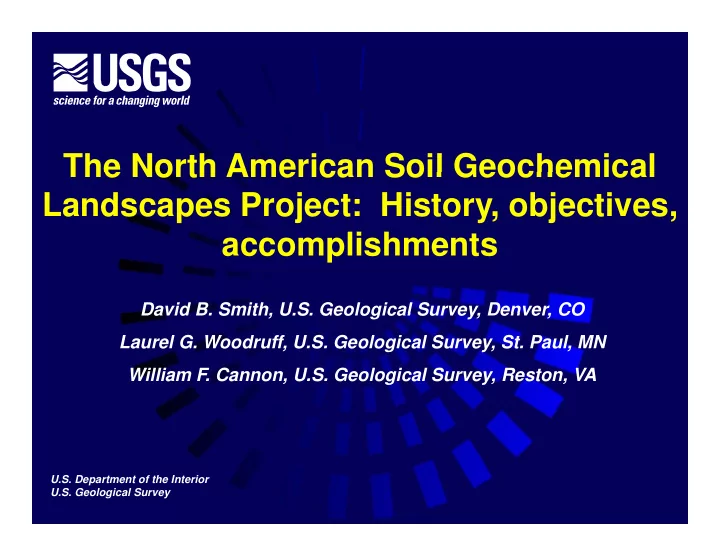

The North American Soil Geochemical The North American Soil Geochemical Landscapes Project: History, objectives, accomplishments accomplishments David B. Smith, U.S. Geological Survey, Denver, CO David B. Smith, U.S. Geological Survey, Denver, CO Laurel G. Woodruff, U.S. Geological Survey, St. Paul, MN William F. Cannon, U.S. Geological Survey, Reston, VA , g y, , U.S. Department of the Interior U.S. Geological Survey
Outline Goals of NASGLP History of NASGLP Status of existing national-scale soil Status of existing national scale soil geochemical data for US Pilot studies Pilot studies Progress and future of NASGLP
The mission of the NASGLP is to: Produce a soil geochemical data base, and its representation in map form, for the continent of North America (21 million km 2 ) Interpret observed geochemical patterns in Interpret observed geochemical patterns in terms of process Establish an archive of soil samples for use Establish an archive of soil samples for use by future investigators
Customer base for NASGLP Anyone interested in “background” Anyone interested in “background” ranges of elements in soil • Risk-based assessment of contaminated land • Establishing soil cleanup or action levels (regional or national scale) • Soil pathways for chronic or acute exposure to p y p toxic elements • Soil-borne pathogens (anthrax)
NASGLP Timeline 2001: Directors of SGM, GSC, USGS identify soil geochemistry as subject of identify soil geochemistry as subject of mutual concern 4 workshops held (2002, 2003, 2004, 2006) p ( , , , ) 2004-2006 Pilot phase in Canada and US 2006-2007 Pilot phase in Mexico 2006 2007 Pilot phase in Mexico 2007 Sampling begins for full continental- scale survey
“Documenting and understanding natural “Documenting and understanding natural variability is a vexing topic in almost every environmental problem: How do we environmental problem: How do we recognize and understand changes in natural systems if we don’t understand the range of baseline levels?” Z b Zoback, GSA Today, December 2001 k GSA T d D b 2001
USGS National-Scale Soil Data (Shacklette Data) (Shacklette Data) 1 323 samples (1 per 6 000 sq km ) 1,323 samples (1 per 6,000 sq. km.) collected from areas with native vegetation vegetation Collected from 1960s to late 1970s 40+ elements analyzed 40+ elements analyzed Still the most-often-quoted data for “background” values of trace elements background values of trace elements in soil
Shacklette sample sites
Pilot Studies 2004-2006 Pilot Studies 2004-2006 Continental scale pilot study Continental-scale pilot study • Two transects, samples collected at ~40 km spacing; test sampling and analytical protocols, p g p g y p field logistics Regional-scale pilot study • Northern California • Designed to represent a more detailed follow- up investigation of area of interest identified up investigation of area of interest identified from low-density continental-scale data
Regional- scale pilot 265 sites, >1,500 , samples
Continuation of transects into Mexico
Samples collected from each site TYPICAL SOIL PROFILE 1: 0 to 5 cm depth (265 samples ) – regardless of p ) g horizon O horizon decayed organic matter 2: O horizon (38 samples) A horizon mineral soil mixed with some organic matter 3: A horizon (244 samples) 4: C horizon or closest C horizon partly altered parent approximation (258 material material samples)
Sample Analysis Near-total extraction for major and trace elements (ICPMS/ICPAES) elements (ICPMS/ICPAES) – USGS USGS Forms of carbon, total sulfur - USGS Water extraction (A horizon) Water extraction (A horizon) – GSC GSC Gastric fluid and lung fluid extraction (0-5 cm) – USGS ) Gamma-ray spectrometry – GSC Phospholipid fatty acid analysis – UC Davis p p y y Enzyme assays – Oregon State University
Sample analysis (continued) p y ( ) BioLog community profiling – USGS Human and agricultural pathogen screening – USGS Quantitative XRD (A and C horizon) – USGS Screen for 22 organochlorine pesticides – contract laboratory
Results from pilot phase published as phase published as special issue of Applied pp Geochemistry (Vol. 24, Issue 8, August 2009) 2009)
Sample design Generalized Random Tessellation Stratified (GRTS) design Stratified (GRTS) design 13,323 sites for North America (about 1 per 1,600 km 2 ) 2 ) 1 1 600 k • US = 5,813; Canada = 6,183; Mexico = 1 32 1,327
Sample types collected at each site f for NASGLP NASGLP 0-5 cm • Separate sample for anthrax A horizon C horizon or closest approximation C horizon or closest approximation
Revised sample analysis Near-total extraction for major and trace elements (ICPMS/ICPAES/AA) l t (ICPMS/ICPAES/AA) Total carbon, carbonate carbon (organic carbon by difference) b b diff ) Presence or absence of Bacillus anthracis (anthrax) (anthrax) Quantitative XRD
c. 4,800 sites sampled from 2007-2010 Data to be available via USGS web site
871 sites sampled in Mexico (66% of total)
472 sites sampled in Canada (7.6% of total)
Samples archived in glass jars
>14,000 samples; ~70 pallets
Pathogenic bacteria in North American soil: A joint USGS-EPA survey il A j i t USGS EPA D l Dale W. Griffin, dgriffin@usgs.gov W G iffi d iffi @
EPA needs background levels of naturally occurring high-priority biothreat agents i hi h i it bi th t t within U.S. soils to establish appropriate cleanup levels if these agents should be cleanup levels if these agents should be used in an intentional contamination event. Bacillus anthracis (anthrax)—all 0-5 cm samples Yersinia pestis (plague)—2 000 samples Yersinia pestis (plague)—2,000 samples Fransicella tularensis (tularemia or rabbit fever)— 2,000 samples
dsmith@usgs.gov your attention. Thank you for
Recommend
More recommend